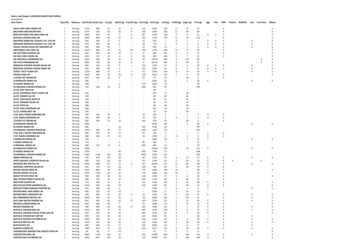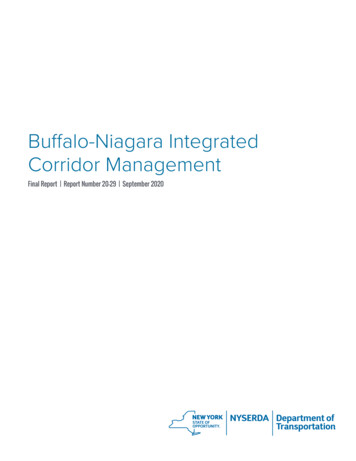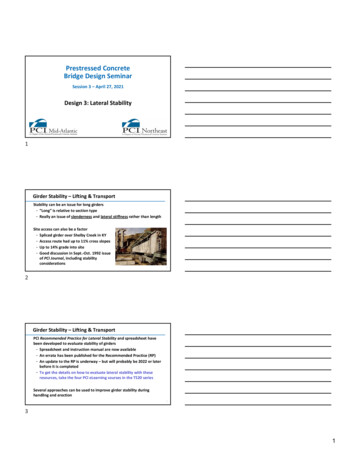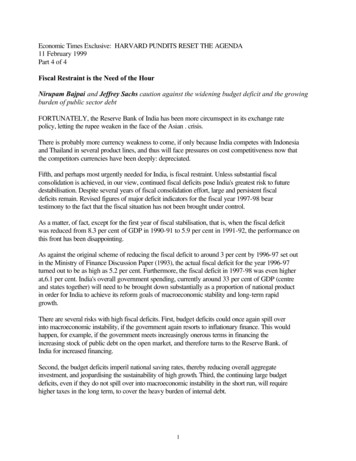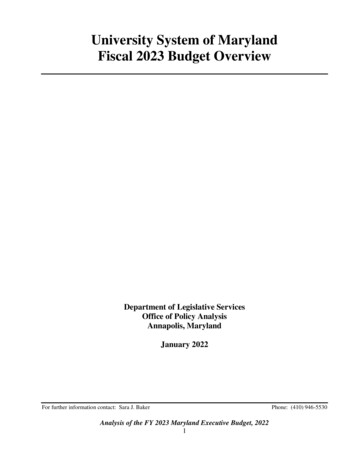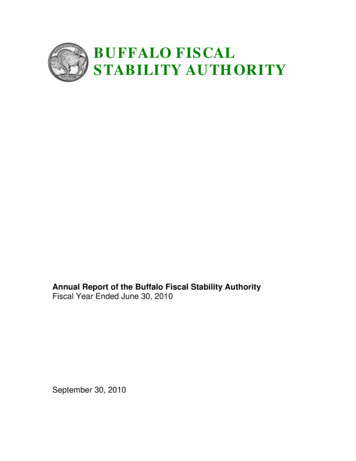
Transcription
BUFFALO FISCALSTABILITY AUTHORITYAnnual Report of the Buffalo Fiscal Stability AuthorityFiscal Year Ended June 30, 2010September 30, 2010
Annual Report of the Buffalo Fiscal Stability AuthorityDirectorsR. Nils Olsen, Jr., ChairAlair Townsend, Vice ChairGeorge K. Arthur, SecretaryJohn J. GiardinoGail E. JohnstoneFrederick G. FlossFrank B. MesiahByron W. Brown (ex officio)Chris Collins (ex officio)ii
StaffJeanette M. Mongold, CPAExecutive DirectorMichael P. Kelly, MPATreasurer/Principal AnalystBryce E. Link, MPAPrincipal Analyst/ Media ContactNathan D. Miller, BSManager of Administration and TechnologyMargreta D. Mobley, MBAComptrollerContactMarket Arcade Building617 Main Street, Suite 400Buffalo, New York 14203Phone: 716.853.0907Media: 716.941.7020Fax: 716.853.9052Email: info@bfsa.state.ny.usWeb: www.bfsa.state.ny.usiii
Annual Report of the Buffalo Fiscal Stability AuthorityTable of ContentsIntroduction . - 1 Background. - 1 Mission Statement . - 3 Governance . - 4 Summary of Accomplishments in 2009-10. - 6 Multi-Year Financial Planning. - 7 Monitoring Fiscal Health. - 8 Workforce Summary and Trends . - 9 Providing a More Cost-Effective Financing Framework . - 11 Structural Reform and Savings Opportunities . - 14 Legal Matters . - 16 Public Meetings and Internal Controls. - 18 Leases . - 21 Performance Measurement. - 21 City of Buffalo and Covered Organizations - ReportsReports on the 2010-11 Budgets & Related 2011-14Four-Year Financial Plans . - 24 City of Buffalo’s Budget and Four-Year Financial Plan . - 28 Buffalo Public Schools Four-Year Financial Plan . - 44 Buffalo Urban Renewal Agency . - 64 Buffalo Municipal Housing Authority. - 71 Joint Schools Construction Board . - 83 -iv
This page was intentionally left blank.v
IntroductionThis is the seventh annual report of the Buffalo Fiscal Stability Authority (the“BFSA” or the “Authority”), known locally as the City Control Board. It covers theseventh fiscal year in which the City of Buffalo (the “City” or “Buffalo”) and itscovered organizations (as defined below) operated under the requirements of theBuffalo Fiscal Stability Authority Act. This report focuses mainly on the periodfrom July 1, 2009 through June 30, 2010, adding to the actions,accomplishments and progress cited in BFSA’s six prior annual reports.The combined efforts of the City and its covered organizations, in cooperationwith the BFSA, have contributed greatly to Buffalo’s fiscal improvement to date.Since BFSA was created in 2003, the City of Buffalo and its taxpayers havesaved more than 237 million. These essential savings were brought aboutthrough the exercise of extraordinary powers granted to BFSA by New YorkState (the “State”), and through the cooperation of the City of Buffalo and itscovered organizations. This has contributed to multiple upgrades in the City’scredit rating as follows: “ improved outlook” from Standard & Poor’s (2003);“improved outlook” from Moody’s (2006); improved rating to BBB-stable fromStandard & Poor’s (2006); improved rating to Baa2 from Moody’s (2007), BBB stable outlook from Standard & Poor’s (2008), A- stable outlook from Standard &Poor’s (2009).Most recently during 2010, the rating agencies recalibrated their ratings.Moody’s rated the City at the A2 level with a positive outlook. Fitch Ratingsrated the City for the first time at the A rating level with a stable outlook.Although the ratings of the City rose, the rating agencies stress that marketparticipants not view the recalibrations of municipal ratings as ratings upgrades,but rather as a recalibration of the ratings to a different rating scale. Therecalibration does not reflect an improvement in credit quality or a change incredit opinion.BackgroundThe Buffalo Fiscal Stability Authority Act was adopted in 2003 in response to aState Comptroller’s report on the City of Buffalo’s financial condition, and adetermination by the New York State Legislature that the City was faced with asevere fiscal crisis that could not be resolved without State assistance. Declaringthe maintenance of a balanced budget by the City of Buffalo a matter of“overwhelming State concern,” the Legislature passed, and Governor George E.Pataki signed, Chapter 122 of the Laws of 2003 – the Buffalo Fiscal StabilityAuthority Act.-1-
According to the BFSA Act and resolution of the BFSA Board, the City of Buffalois understood to include certain “covered organizations,” currently including theCity’s fiscally dependent School District, the Buffalo Urban Renewal Agency(BURA), the Buffalo Municipal Housing Authority (BMHA) and the Joint SchoolsConstruction Board (JSCB).The BFSA Act, adopted with unanimous bipartisan support in the StateLegislature, included the following provisions to return the City of Buffalo to fiscalstability: Established BFSA as a fiscal control agency over the City and its coveredorganizations; Required the annual development of a four-year financial plan for the Cityand its covered organizations, and vested BFSA with the power to ensurecompliance with that plan; Granted BFSA the power to provide deficit financing assistance to the Cityand its covered organizations over a four-year period, provided thatrecurring actions were taken to close increasing percentages of thestructural budget gap each year; Established the legal basis for creation of a highly rated borrowingstructure to reduce City borrowing costs and provide short-term budgetaryassistance; and Empowered BFSA to impose financial control mechanisms if the City andits covered organizations are unable to adopt a balanced financial planand / or operate in accordance therewith.Under the BFSA Act, the BFSA began its existence during a “control period,”which means that the BFSA commenced operation with its maximum authorizedcomplement of financial control and oversight powers. During such a controlperiod, BFSA retains significant powers to protect the integrity of the City’sfinancial condition. Among them are the power to review and approve ordisapprove contracts, including collective bargaining agreements entered into bythe City or any covered organization; to approve or disapprove the terms ofborrowings by the City and covered organizations; to approve, disapprove ormodify the City’s financial plans and take any action necessary in order toimplement the financial plan; to impose a wage or hiring freeze, or both, withrespect to employees of the City or any covered organization; and to review theoperation, management, efficiency and productivity or the City and any coveredorganization.-2-
The BFSA Act provides that the Authority shall have different financial controland oversight powers depending upon whether the City’s financial conditioncauses it to be in a “control period” or an “advisory period.” In BFSA’s view, thecontrol period would end upon receipt of the audited financial statements fromthe covered organizations for the fiscal year ending June 30, 2010, and a jointcertification from the City Comptroller and State Comptroller stating thatsecurities were sold in the immediately preceding fiscal year in the general publicmarket and that there is a substantial likelihood that the City will be able to sellsuch securities in the general public market during the next fiscal year. Uponreceipt of these items, it is expected that BFSA will transition into an “advisoryperiod.” During such an advisory period, BFSA is empowered, among otherthings: to review the operation, management, efficiency and productivity of Cityoperations and of any covered organization’s operations, and to make reportsand recommendations thereon; to review and comment on the provisions of thebudget and four-year plan and any financial plan modification; to auditcompliance with the City’s financial plans; to review and comment on the terms ofany proposed borrowing, including the prudence of each proposed issuance ofbonds or notes by the City; to assess the impact of any collective bargainingagreement that in the judgment of the Authority may have a significant impact onthe City’s long-term fiscal condition, and to reimpose a control period if the City’sfinances meet certain statutorily defined conditions.Mission StatementThe Buffalo Fiscal Stability Authority originally adopted its mission statement onSeptember 24, 2007. The Authority’s Mission Statement includes the followingportions of Chapter 122 of the Laws of 2003:The city budget must be balanced and economic recovery enhanced.Actions should be undertaken which preserve essential services to cityresidents, while also ensuring that taxes remain affordable. It is herebyfurther found and declared that a control and advisory finance authorityshould be established to oversee the city’s budget, financial and capitalplans; to issue bonds, notes or other obligations to achieve budgetarysavings through debt restructuring; to finance short-term cash flow orcapital needs; and, if necessary, to develop financial plans on behalf of thecity if the city is unwilling or unable to take the required steps toward fiscalstability.The legislature further finds and declares that maintenance of a balancedbudget by the city of Buffalo is a matter of overriding state concern,requiring the legislature to intervene to provide a means whereby: thelong-term fiscal stability of the city will be assured, the confidence ofinvestors in the city’s bonds and notes is preserved, and the economy ofboth the region and the state as a whole is protected.BFSA’s Board of Directors most recently reapproved the Authority’s Mission-3-
Statement on July 21, 2010.GovernanceBFSA is governed by a nine-member Board of Directors. Seven are appointedby the Governor, one of which is upon the recommendation of the StateComptroller and another of which is upon the joint recommendation of theleaders of the State Assembly and the State Senate. The Mayor of the City ofBuffalo and the Erie County Executive serve on the Board in ex officio capacities.The Governor designates the Chair and Vice Chair.As of June 30, 2010, the following individuals served on BFSA’s Board ofDirectors: R. Nils Olsen, Jr., ChairFormer Dean of the University at Buffalo Law School and currentProfessor of Law at the UB School of Law Alair Townsend, Vice ChairColumnist of Crain’s New York Business George K. Arthur, SecretaryFormer President, Buffalo Common Council John J. GiardinoSpecial Counsel with Phillips Lytle LLP and Managing Partner withArtemis Capital Partners Gail E. JohnstoneFormer President and CEO of the Community Foundation for GreaterBuffalo Frederick G. Floss, Ph.D.Professor of Economics and Finance, Buffalo State College Frank B. MesiahPresident of the Buffalo Chapter of the NAACP and former RegionalAdministrator with the NYS Department of Labor Byron W. Brown (ex officio)Mayor, City of Buffalo Chris Collins (ex officio)County Executive, Erie County-4-
BFSA maintains two standing committees, the first of which is the Audit, Financeand Budget Committee. This committee is chaired by R. Nils Olsen and DirectorsAlair Townsend and Fred Floss constitute the remaining committee members.The second committee is the Governance Committee and is chaired by R. NilsOlsen and Directors George Arthur and Gail Johnstone constitute the remainingmembers of the committee.Attached to this report are BFSA’s Charter, By-Laws and Audited FinancialStatements for 2009-10.At June 30, 2010, BFSA had the following staff members: Jeanette M. Mongold, C.P.A. (Executive Director)Former Deputy Comptroller with the City of Buffalo and former SeniorManager with Deloitte and Touche, Buffalo, New York. Michael P. Kelly, M.P.A. (Treasurer/Principal Analyst)Former community planning and development specialist and presidentialmanagement fellow for the Community Planning and DevelopmentDivision, U.S. Department of Housing and Urban Development,Washington, D.C. Margreta D. Mobley, M.B.A. (Comptroller)Former BFSA principal analyst, former finance manager of accountingpolicies and procedures and Sarbanes-Oxley implementation, GeneralMotors; Controller’s Staff, General Motors Corporation; and Treasurer ofthe General Motors Foundation. Bryce E. Link, M.P.A. (Principal Analyst/Media Contact)Former BFSA analyst, senior analyst and former budget fellow andexaminer with the State Division of the Budget’s Expenditure Debt Unit. Nathan D. Miller, B.S. (Manager of Administration and Technology)Former BFSA executive assistant / office manager and formeradministrative assistant with Child and Family Services.-5-
Summary of Accomplishments in 2009-10In its seventh fiscal year of operation, BFSA continued to assist the City and itscovered organizations in attaining long-term fiscal stability. While there istangible evidence of the City’s progress emerging during the 2009-10 fiscal year,there are significant financial challenges that the City and the coveredorganizations are facing. Certain key indicators include the following:-Moody’s Investors Service, as part of its recalibration, affirmed the City’scredit rating at A2 with a positive outlook citing the City’s improved fiscalreserves and BFSA’s continued oversight. In 2010, when Moody’srecalibrated and affirmed the City’s rating, the rating agency issued thefollowing statement “improvement of the city's financial reserve andliquidity positions following augmentation of reserves in each of the lastseven years and a trend of structurally balanced operations that isexpected to continue in fiscal 2010 ”-Standard & Poor’s affirmed the City’s A- rating with a stable outlook for itsgeneral obligation long-term debt in the 2009-10 fiscal year citing theongoing relationship between the City and BFSA, management’swillingness to adopt many of BFSA’s control mechanisms and generalfund operating surpluses in each of the past five fiscal years. Previously(in 2009), S&P upgraded the City credit rating from BBB to A-, reflecting“the city’s improved financial profile, stronger financial managementcontrols, and continued advisement provided by the Buffalo Fiscal StabilityAuthority. The outlook is stable.” S&P also cited the ongoing relationshipbetween the City and BFSA, which together have worked to achievestructurally sound operations for three consecutive years, as well as afour-year financial plan that clearly identifies out-year operating gaps andgap-closing measures, City management’s willingness and proactiveapproach in adopting many of the BFSA control mechanisms into its owncharter, adding long-term stability to the credit, and structurally soundgeneral fund operating surpluses achieved in each of the past three fiscalyears, resulting in strong accumulated general fund reserves. Fitch Ratings assigned an ‘A ‘ rating to the City’s 2010 general obligationbonds with a stable outlook. In Fitch’s first rating of the City the agencycited, “strong reserve levels, conservative policies and strongmanagement, BFSA oversight, the City’s diverse economic base andstable revenues.” Fitch’s rating occurred approximately during the ratingagencies’ recalibrations that occurred in 2010. The City’s total General Fund fund balance increased from 133.3 millionat June 30, 2008 to 138.6 million at June 30, 2009. However, the City’sunreserved, undesignated fund balance decreased from 58.93 million at-6-
June 30, 2008 to 48.20 million at June 30, 2009. Total unreserved fundbalance, which includes the Rainy Day Fund, decreased from 113.5million to 101.0 million. The City’s Rainy Day Fund, representing aminimum of 30 days of the prior year’s general fund expenditures, whichmay be used for unforeseen capital or operating expenditures, increasedfrom 30.18 million to 33.64 million during the 2008-09 fiscal year. TheCity’s total unreserved, undesignated fund balance was 76.02 million atJune 30, 2007. The City has not settled current labor contracts with itstwo largest unions, representing police and fire. The School District’s total fund balance increased from 119.32 million atJune 30, 2008 to 169.89 million at June 30, 2009. Total unreserved fundbalance at June 30, 2009 of 138.25 million increased from its level atJune 30, 2008 of 99.15 million. Unreserved, undesignated fund balanceincreased from 33.80 million at June 30, 2008 to 42.58 million at June30, 2009. The District has not settled current labor contracts with its twolargest unions, representing the teachers and the administrators.The significant financial oversight, monitoring and control actions taken by BFSA,the City and its covered organizations in the seventh year of BFSA’sresponsibilities fall into the following categories:Multi-Year Financial PlanningThe multi-year financial planning process represents the core of BFSA’s financialoversight, and is one of the most critical components to Buffalo’s fiscal stability.With BFSA’s assistance, the City and covered organizations have developed andmaintained a comprehensive financial planning process that has helped toaddress structural budget gaps as well as to recognize and prepare for futurefiscal challenges.In 2009-10, BFSA monitored implementation of the seventh four-year financialplan for the City and its covered organizations. That plan covered fiscal yearsending 2010 through 2013, and contained budget balancing measures the Citydid not need to implement in recent years. For example, the City’s four-year plananticipated the use of 28.3 million in unreserved, undesignated fund balance, aswell as the use of 20.2 million in restricted AIM to be able to balance the fouryear financial plan. The School District included Programs to Eliminate the Gap(PEGs) in each year of its financial plan to balance its budget. The SchoolDistrict’s four-year financial plan contained operating deficits each year for 2010– 2013 which altogether totaled 142 million.BFSA also approved the eighth four-year financial plan for the City and itscovered organizations in June 2010, covering fiscal years ending 2011 through2014. The new financial plan was the fourth consecutive plan since 2006-07 thatdid not rely on the savings of a wage freeze.-7-
Monitoring Fiscal HealthRegular and aggressive monitoring of spending, budgetary processes and costsavings initiatives are essential to ensuring that Buffalo continues its progresstowards fiscal stability. Under BFSA, the City and covered organizations havedeveloped a reliable reporting process for revenues, expenditures, cash flow,workforce size and the status of gap-closing measures. This process has yieldeda more disciplined approach to fiscal monitoring, and enabled immediate budgetmodifications as needed during the fiscal year.In 2009-10, BFSA continued the regular quarterly reporting process by the Cityand its covered organizations to review financials and determine if modificationswere required. The following summarizes many, but not all, actions BFSA took in2009-10:-BFSA approved seven City budget modifications during the fiscal year. InMarch 2010, the Board approved a budget modification utilizing 2 millionof the City’s general fund reserved fund balance for capital outlays for theacquisition of various vehicles and equipment for the Department of Parksand Recreation. In June 2010, the Board approved six budgetmodifications. The first utilized Justice Assistance Grant proceeds( 32,490) for wages tied to the hiring of five camera monitors in the policedepartment for the remainder of the fiscal year. The second utilized fundsfrom the reserved fund balance for emergency medical services( 200,000) previously received and budgeted from the Department ofHomeland Security to the Buffalo Fire Department for a Mass CasualtyAmbulance Bus. The third budget modification utilizes 300,000 from theCity’s general fund revenue to be transferred to the Olmsted ParksConservancy for payroll costs. The fourth modification transfers 1,435,000 from Restore New York program funds for additional injuredon-duty payments, additional VOIP telephones in the Department of PublicWorks, repairs to outside buildings and current year demolitions. The fifthbudget modification transfers 1,374,820 from the City’s unreserved,designated fund balance for various claims and litigation to cover costsresulting from an arbitrator ruling that the City must repay PBA membersfor health care contributions withheld by the City retroactive to July 1,2004, while the final budget modification approved at the June BFSAmeeting approved the transfer of 300,000 from the City’s general fund tothe Colored Musicians Club for various improvements to the club. BFSA approved the City’s 22.7 million capital improvement budget inFebruary 2010. The plan met the requirements contained in BFSA’s prioryear approval that the City develop a full five-year capital improvementprogram. BFSA’s approval was conditioned on the City “continu(ing) toreduce its use of capital borrowing for short-term operating expenses thatare not supported by a long-term physical asset with the goal of-8-
eliminating the practice ” and “continu(ing) to rescind authorized butunissued debt whenever possible.” Recognizing the improved financial situation of the City, BFSA authorizedthe City in June 2010 to borrow approximately 27.6 million in the publicmarkets to finance capital projects for itself and its dependent schooldistrict. BFSA staff monitored the process and pricing of the issue. BFSA approved the Buffalo Municipal Housing Authority’s 10.1 millioncapital budget in May 2010 for improvements and redevelopment ofBMHA’s housing stock. BFSA reviewed and approved 187 City contracts and obligations totaling 65.4 million; 173 School District contracts and obligations totaling 201.5million; 29 BMHA contracts and obligations totaling 20.2 million and 53BURA contracts and obligations totaling 22.1 million.Workforce Summary and TrendsWorkforce costs represent the single largest expenditure category in the City andits covered organizations. In the City in 2009-10, the costs of employee salaries,pensions, health insurance (for active and retired employees) and other benefitsaccounted for 82 percent of budgeted spending. In the School District, itrepresented 60 percent (i.e., for the general fund). In addition, workforce costsare among the fastest-growing budget categories due to significant increases infringe benefits, in particular health insurance and most recently an increase inpension contributions. The City’s liability for its retiree health insurance costs,representing its Other Postemployment Benefit (OPEB) liability, was required tobe recorded at June 30, 2008, according to the Governmental AccountingStandards Board (GASB). This estimate is required to be updated every twoyears. The City’s OPEB obligation at June 30, 2009 was estimated at 1.2billion, while the School District’s obligation was also estimated at 1.2 billion.The City’s long-term fiscal stability remains directly tied to its ability to managethe size and cost of its workforce.In 2009-10, while the City decreased its budgeted workforce by a net 13positions, filled positions actually increased by 79 to 2,457. BMHA’s workforcewas essentially static, decreasing one position to a total of 228 filled positions.The School District’s budget reduced employment levels by 4 positions, whilefilled positions increased by 13 positions to 5,493; it is noted that staff levelsremain below 2003-04 levels. BURA had 54 positions both budgeted and filled atthe conclusion of the 2009-10 fiscal year. BURA’s workforce size remainssignificantly below 2003-04 levels when BFSA was created. Additionally, BURAfully funds 5 positions in the City’s Office of Strategic Planning. The followingcharts detail both the City and School District’s staff levels since 2003.-9-
City Workforce Size(number of 004200520062007200820092010School District Workforce Size(number of 0201620020052007420020032005,493- 10 -
Providing a More Cost-Effective Financing FrameworkOver four years, from 2004 through 2007, BFSA reduced the City’s capital andcash flow debt costs; refunded existing City debt at more beneficial interest rates;and provided short-term budgetary relief through deficit financing (although thestatutory power to undertake deficit financing expired at the end of the 2006-07fiscal year). This was possible due to BFSA’s highly-rated credit as compared tothe City’s bond ratings, which enabled savings for the City upon issuance of itsDeclaration of Need.BFSA’s own credit rating has been upgraded by rating agencies. In 2007, FitchRatings upgraded BFSA to AA from AA- to reflect “the demonstratedeffectiveness of the Buffalo Fiscal Stability Authority in assisting the recentimprovement of the city of Buffalo’s fiscal condition.” This followed a ratingupgrade from Moody’s Investors Service in 2006 to Aa2 from Aa3. Theseupgrades further enhanced financing savings BFSA was able to produce for theCity. When Moody’s recalibrated ratings in 2010, BFSA was rated at the Aa1level, while Fitch rated BFSA at the AA level after the recalibration occurred.Pursuant to the BFSA Act, all of the City’s State aid, along with both the City andSchool District’s portions of the local sales tax, are legally revenues of BFSA.The first call on those revenues is to pay any debt service, which allows BFSA toachieve a rating superior to the City’s (for 2010 the City’s ratings were A- fromStandards & Poor’s, A2 from Moody’s and A from Fitch).Since BFSA was created in 2003, the City’s credit rating has improved from BBBwith negative outlook to A- stable from Standard & Poor’s, and from Baa withnegative outlook to A2 positive outlook from Moody’s Investors Service (after therecent recalibration). In its rating upgrade report, Moody’s states that theupgrade reflects “improvement of the city’s financial reserve and liquiditypositions following augmentation of reserves in each of the last seven years anda trend of structurally balanced operations that is expected to continue in 2010.”Moody’s further cited BFSA continued oversight role. 2010 was the initial year inwhich Fitch Ratings rated the City of Buffalo. It is noted that currently the ratingoutlook from all three rating agencies is stable.- 11 -
The following table illustrates credit rating comparisons between BFSA and theCity of Buffalo in 2010:BFSA'sRatingCity’s Rating Moody's / S&PMoody’sS&P / FitchAaaAAAHighest Investment Grade / Minimal RiskHighest Investment GradeAa1AA High Investment Grade / Very Low RiskHigh Investment GradeAAGood Investment GradeGood Investment GradeA2A-Upper Medium Grade / Low RiskUpper Medium GradeA City’s Rating FitchUpper Medium GradeBaaBBBModerate RiskModerate RiskBaBBSpeculative / Substantial RiskSpeculativeFor the year ended June 30, 2010, the BFSA earned or accrued a total of 734,706 in investment earnings from funds held in various bond relatedaccounts, from state funds held on behalf of the City and from funds in its ownoperating accounts.During the year under review, at the request of the City and in recognition of theimprovements in the financial condition of the City, the BFSA authorized the Cityto borrow 27,600,000 on its own for City and School District capital needs.BFSA monitored the transaction process and the pricing. Unlike 2008-09, BFSAdid not approve a cash flow borrowing by the City as a private placement. In2008-09 it was later determined that the City would have sufficient resources anddid not need to borrow.- 12 -
The following table contains a listing of all BFSA debt transactions since theAuthority was created, as well as amounts outstanding as of June 30, 2010:BFSA Debt Table atJune 30, 2010IssueBond Par( in thousands)DateIssuedJun04 25,745Sales Tax and State AidSecured Bonds (Series2004A)Bond Anticipation Notes(Series 2004A-1)Sales Tax and State AidSecured Bonds (Series2005A)Sales Tax and State AidSecured Bonds – Refunding(Series 2005B&C)Bond Anticipation Notes(Series 2005A-1)Sales Tax and State AidSecured Bonds (Series2006A)Bond Anticipation Notes(Series 2006A-1)Sales Tax and State AidSecured Bonds (Series2007A)TotalSep04Note(BAN)ParIssuedBond ParNote ParOutstandingOutstanding 14,525 84,000 0Jun05 28,030 20,465Jul05 47,065 36,655Jul05Apr06 90,000 27,270Sep06Apr07 0 23,315 60,000 28,470 156,580 0 26,160 234,000- 13 - 121,120 0
Structural Reform and Savings OpportunitiesThe identification and implementation of new cost-savings initiatives is critical tothe long-term fiscal stability of the City and its covered organizations. Byintroducing new actions each year through the financial plan, the City has madestrides in resolving its structural
Fax: 716.853.9052 Email: info@bfsa.state.ny.us Web: www.bfsa.state.ny.us . iv Annual Report of the Buffalo Fiscal Stability Authority Table of Contents . negative outlook to A2 positive outlook from Moody's Investors Service (after the recent recalibration). In its rating upgrade report, Moody's states that the



